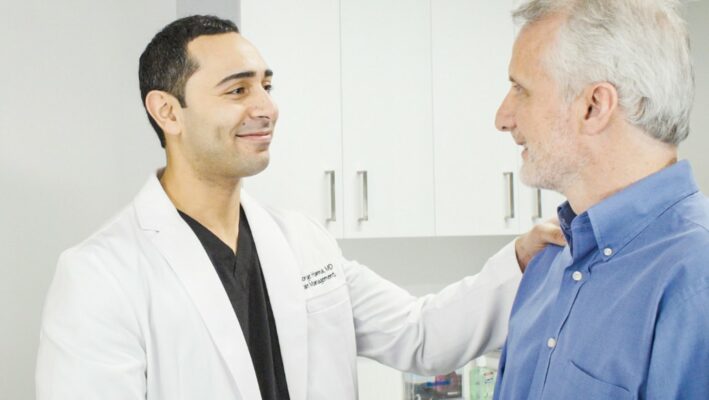If you have myofascial pain syndrome, you may experience aching muscular pain throughout your body. This pain can affect your mobility, mood and energy level, making daily activities difficult. Myofascial pain syndrome (MPS) is a chronic pain condition. It affects soft tissue: muscles, and fascia (covers muscles). The specific sites of injury to these tissues are called myofascial trigger points. Trigger points feel like tender knots beneath the skin, and are commonly found in the jaw, low back, pelvis, arms and legs. These points can be spontaneously or actively triggered. They may also be associated with numbness, twitching and sleep disturbance. If your pain is severe or significantly affecting your life, you should consider a visit with a qualified pain physician to diagnose your pain. Pain physicians can help you begin to treat the pain immediately, and avoid complications and permanent damage.

Self-care
Obtain adequate sleep and a healthy diet rich in vegetables, fruits, whole grains, healthy fats and lean meats to better equip yourself mentally and physically to cope with pain. You may also benefit from sharing your feelings and experiences of chronic pain. A pain doctor can refer you to a mental health professional.
Stress & relaxation techniques
Practice mindfulness and other relaxation therapies to help release bodily tension and decrease your pain. A pain specialist can refer you to a trained professional.
Heat
Apply a hot pad for 15 minutes at a time to decrease bodily stiffness.
Stretching and conditioning exercises
Perform stretches and conditioning exercises at home to improve strength and posture and decrease pain. A pain specialist can determine which stretches and exercises are right for you.
Anti-inflammatory medications and physical therapy
Anti-inflammatory pain relievers such as Motrin, Advil and Aleve, and physical therapy work to reduce your myofascial pain. A pain physician can refer you to a physical therapist.
Massage therapy
Massage therapy can help to release bodily tension and decrease your pain. A pain specialist can refer you to a massage therapist.
Biofeedback therapy
Sensors attached to the body aid in learning how to control your body’s physiological states, including muscle tension and pain. A pain specialist can refer you to a trained professional.
Music and vibration therapy
Music and vibration therapy can reduce bodily tension and pain. A pain specialist can refer you to a trained professional.
Electromedicine
Transcutaneous electrical nerve stimulation (TENS), laser therapy and therapeutic ultrasound can increase blood circulation, accelerate natural healing, and reduce bodily tension and pain. A pain specialist can refer you to a trained professional.
Dry needling with or without heat
This needle procedure has long treated myofascial pain. Insertion of a room temperature or heated needle into the trigger point breaks up muscle tension and reduces pain. A specially trained pain specialist can perform this procedure for you.
Wet needling with local anesthetic
Insertion of a needle with local anesthetic into the trigger point not only breaks up muscle tension, but also blocks the triggering nerves from feeling pain. A specially trained pain specialist can perform this procedure for you.
Trigger point injections
Pain medicine specialists inject a small needle containing saline, local anesthetic and possibly steroid, botox or platelet rich plasma. Platelet rich plasma uses your own blood platelets and growth factors to accelerate the natural healing process and reduce pain. Botox and steroid also reduce pain. These injections can enable you to participate in physical therapy. Many people consider trigger point injections to be the single most effective therapy available for myofascial pain syndrome and related conditions.
What Causes Myofascial Pain Syndrome?
Although there are many causes of MPS, the most common cause is strain or injury of a muscle, ligament or tendon. Ligaments and tendons are fibrous bands of tissue; ligaments connect bone to bone, and tendons connect muscle to bone. Other causes of MPS include:
- Skeletal and joint abnormalities, such as abnormal spine curvature, uneven leg length or osteoarthritis
- Injured or slipped discs, such as from heavy lifting
- Overuse of unconditioned muscles
- Inactive lifestyle or poor posture
- Arm or leg immobilization, such as from being in a cast
- Fibromyalgia
- Prior surgeries
- Certain medical conditions, such as cardiovascular, gastrointestinal, infectious or hormonal diseases
- Hormonal changes, such as pre-menstrual syndrome or menopause
- Depression, anxiety and stress
- Vitamin and other nutritional deficiencies
- Certain medications, such as oral contraceptive pills
- Prolonged exposure to cold
- Smoking
What Type of Doctor Can Help You if Home Treatments Fail?
If your myofascial pain does not improve with home treatments, you should consider visiting a pain specialist right away. A pain medicine specialist is a doctor who has specialized training in preventing, evaluating and treating pain conditions. If you are looking for a premier pain management clinic, that accepts most health insurance plans, check out Pain Treatment Specialists. Pain Treatment Specialists clinics are located in New York City, and in Clifton and Wayne, New Jersey. They can assist in treating all kinds of myofascial pain. Pain Treatment Specialists are also affiliated with one of the best vein medicine clinics nationally, VIP Medical Group.
Why Visit a Pain Treatment Specialists Clinic in N.Y. or N.J.?
The pain doctors at Pain Treatment Specialists are Harvard-trained and board-certified with the American Board of Anesthesiology Pain Medicine. In addition to having the best training, Pain Treatment Specialists are compassionate with thoughtful bedside manner. Our skilled physicians are able to perform the most advanced pain medicine interventions available on the market. A pain doctor at Pain Treatment Specialists will work with you to accurately diagnose your MPS with a physical examination; electromyography (EMG); and X-ray, ultrasound, CT or MRI imaging studies. They will explore further myofascial pain syndrome treatment options, like needle procedures and trigger point injections, that are minimally invasive and have long-lasting effects. When at all possible, Pain Treatment Specialists will avoid treating with narcotic pain medications or surgery, but will refer you to an orthopedic surgeon if need be.






